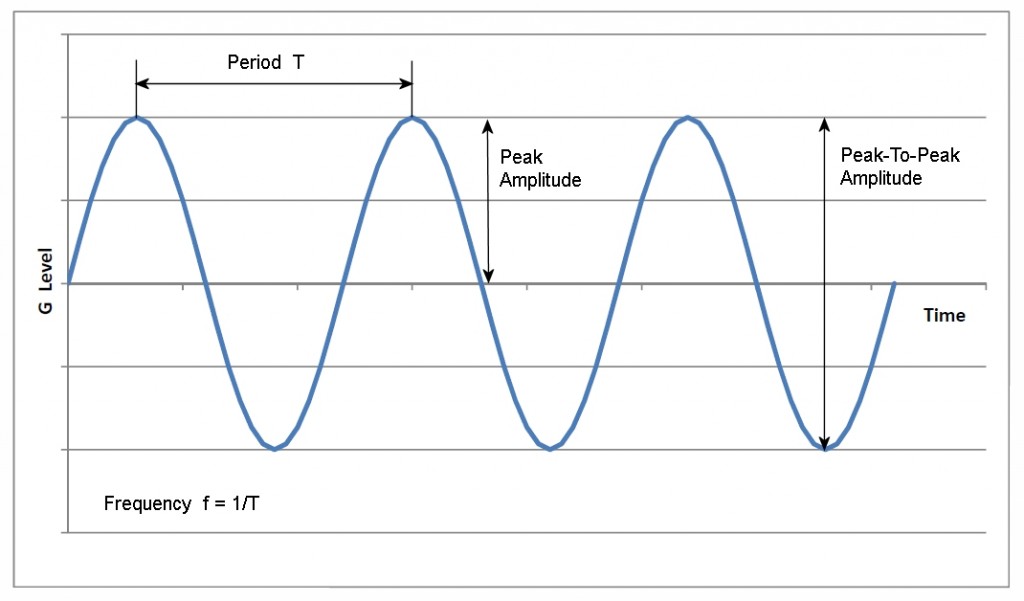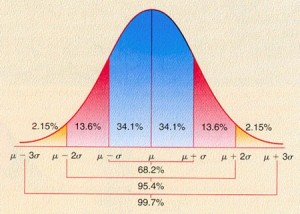The most common types of vibration testing services conducted by vibration test labs are Sinusoidal and Random. This primer is an explanation of the typical requirements found in vibration test specifications and the parameters used to control the vibration tests. Both types of vibration tests are used to evaluate products for ruggedness, durability and to expose vibration defects.
See Sinusoidal Vibration Basics to learn more about vibration fundamentals.
See Sinusoidal Vibration Testing to learn more about the different types of sinusoidal vibration testing.
Examples of vibration test videos can be found on our YouTube page.
Sinusoidal or Sine Vibration Testing
Sinusoidal or Sine Vibration has the shape of a sine wave as seen in Figure 1. The parameters used to define sinusoidal vibration testing are amplitude (usually acceleration or displacement), frequency, sweep rate and number of sweeps.

A typical sinusoidal vibration test profile is shown in Figure 2. The amplitude is defined over a range of frequencies. The amplitude can be constant or variable. During a sine vibration test, the vibration wave forms are swept through a range of frequencies, however they are of discrete amplitude, frequency and phase at any instant in time. An important note is that the displacement increases as the frequency decreases for a given acceleration. At low frequencies, the displacement could exceed the limits of the test equipment. That is why some specifications use displacement for amplitude in the low frequency range.

Sine vibration is not usually found in the real world unless your product is attached to equipment such as a motor or reciprocating compressor running at a fixed frequency. Why is it done? It is good to find resonances (amplitude magnification in the device under test), it is a simple motion and it also produces a constant acceleration vs. frequency. Also, it is probably carried over from old test methods prior to digital computer controllers. However sine vibration does not correlate to a field life unless the product is exposed only to fixed frequencies over its life.
Some parameters and definitions of a sine vibration test are:
Amplitude: The amplitude for a sine vibration test is usually specified as displacement or acceleration. In DES’s experience, velocity is rarely used in a specification. As seen in Figure 1, amplitude can be expressed as peak or peak-to-peak. When displacement is used to define amplitude, it is defined in either peak units of inSA (mmSA) or peak-to-peak units of inDA (mmDA). SA stands for Single Amplitude (peak) and DA stands for Double Amplitude (peak-to-peak). When acceleration is used to define amplitude, its units are usually G’s or millimeter per second squared (mm/sec^2) or meter per second squared (m/sec^2).
Frequency: Frequency is defined as cycles per second. Its’ units are Hertz (Hz). Frequency is equal to the reciprocal of the period.
G: One G is equal to the acceleration produced by earth’s gravity and is equal to 386.1 inches/sec^2 or 9.8 m/sec^2.
Octave: The interval between one frequency and another differing by 2:1.
Period: The time it takes to complete 1 cycle. Its’ units are seconds. Period is not typically used in the definition of a sine test. It is listed here because of its relation to frequency. Period is the reciprocal of the frequency.
Resonance: A frequency at which an amplitude magnification occurs in the device under test when compared to the vibration table amplitude. Usually a resonance is defined as a 2:1 or greater magnification.
Sweep and Sweep Cycles: A sweep is defined as a traverse from one frequency to another. A sweep cycle varies from one frequency to another and then back to the staring frequency. For instance in Figure 2, a sweep could be a traverse from either 5 to 500 Hz or from 500 to 5 Hz. A sweep cycle would traverse from 5 Hz to 500 Hz, then traverse back to 5 Hz. Some specifications require sweeps while others require sweep cycles which causes confusion.
Sweep Rate: The rate at which the frequency range is traversed. The units for sweep rate are usually Octave/minute or Hz/minute. Octave per minute is a logarithmic sweep rate while Hz/minute is a linear sweep rate.
Random Vibration Testing
Random Vibration is a varying waveform. It’s intensity is defined using a Power Spectral Density (PSD) spectrum. Whereas sinusoidal vibration occurs at distinct frequencies, random vibration contains all frequencies simultaneously. Also phase changes occur over time with random vibration. Sine and random vibration testing cannot be equated.
Real world vibrations are usually of the random type. Vibrations from automobiles, aircraft, rockets are all random. A random vibration test can be correlated to a service life if the field vibrations are known. Since random vibration contains all frequencies simultaneously, all product resonances will be excited simultaneously which could be worse than exciting them individually as in sine testing.
A typical random vibration test PSD is shown in Figure 3. The PSD is defined over a range of frequencies. The square root of the area under the PSD curves yields the Grms. Specifying Grms only is not sufficient because a wide variety of spectra can result in the same Grms.

Some parameters and definitions of a random vibration test are:
Averages: Since random vibration constantly changes over time (that is why it is called random), the controller takes samples or snap shots of the vibration data over time. Successive samples are averaged. The averaging occurs in each band of resolution.
Average Weighting Factor: An exponential weighting factor that defines how fast the controller reacts to changes. The controller reacts faster for small weighting factors vs. slower for larger weighting factors.
Statistical Degrees Of Freedom (SDOF): The number of independent values (measurements) used to obtain a PSD estimate at a particular frequency. A higher SDOF means that more measurements are taken.
- For a measurement channel, SDOF = 2*K,
- For control channels, SDOF = 2*K*(2*N – 1) * n.
- K = Number of averages per control loop
- N = Averaging weighting factor
- n = Number of control channels
Grms: Grms is used to define the overall energy or acceleration level of random vibration. Grms (root-mean-square) is calculated by taking the square root of the area under the PSD curve.
Kurtosis: Fourth moment of the Probability Density Function (PDF). It measures the high G content of the signal. The kurtosis of a Gaussian PDF is 3.
Number of Lines: The frequency range of the test divided by the band resolution equals the Number of Lines. The vibration controller or spectrum analyzer will perform its calculations for each narrow band.
Open Loop/Closed Loop: Closed loop means the controller will continuously adjust the drive signal to account for changes in the response of the device under test that are fed back from the control accelerometers. Open loop means the drive signal will be fixed or the controller will stop adjusting the drive signal regardless of changes in the response of the device under test.
PDF: A statistical Probability Density Function. A histogram showing the probability of occurrence and the distribution of data.
Power Spectral Density (PSD) or Acceleration Spectral Density (ASD): Defines the intensity of the random vibration signal vs. frequency. Its units are usually G^2/Hz or (m/s^2)^2/Hz.
Sigma (σ) & Sigma Clipping: Sigma is the standard deviation of a statistical PDF. A Gaussian PDF distribution is assumed for random vibration which takes the shape of a bell shaped curve. Since the amplitude or intensity of the random vibration will change over time, the time spent at different amplitude excursions is measured using a PDF. Figure 4 shows a Gaussian PDF. The vertical axis would be 1/G, the horizontal axis would be sigma and µ is the mean which is equal to zero for a shaker control. For a Gaussian distribution, 68.2% of the peak G excursions occur between ± 1 sigma, 95.4% between ± 2 sigma, 99.7% between ± 3 sigma.

Vibration controllers allow you to clip peak amplitude excursions using Sigma Clipping. Many specifications allow the clipping to be set at ± 3 sigma.
Frequency, G, octave, period and resonance are the same as defined under sinusoidal testing.
For more information on Vibration Shock Testing or other testing services contact DES or call 610.253.6637.
Very well explained
Very very detailed explaination,useful for the starters who r new in this study
I have a very high ASD lever, and wanted to split the test into two frequency bands. Is there a specification that allows this or disallows this? Currently my shaker is not capable of the full spectrum
There are some specifications that allow the frequency range to be split for sinusoidal vibration. I do not know of any random vibration specifications that allow you to split up the frequency range. That would be a good question for the Linkedin Group Vibration and Shock Test, https://www.linkedin.com/groups/737267.
A well compiled article on Sine and random vibration. Even a beginner will understand with ease. Hats off!!!!!
I am A test engineer at GT Group In Peterlee Co. Durham and I need to random sine vibration testing on valves that go on truck engines at temperatures of minus 40 degrees to 130 degrees C are you able to test to theses conditions?
Best Regards
Steve
Yes we can.
excellent technical article write a book on vib
The only thing that was left out was what does the vibration test represent in actual movement of the unit. Sinusoidal vibration a point on the test article will describe a circle, in a plane inclined 45 degrees to the horizontal plane, the diameter of which is equal to the double amplitude specified.
we need a extra guidelines
I have a spec for “Vibration Resistance” that reads: >10/2 G frequency: 10 to 200 Hz. The frequency part is pretty obvious – any idea how to interpret the acceleration part (>10/2 G) of this spec?
No idea. It looks like a typo.